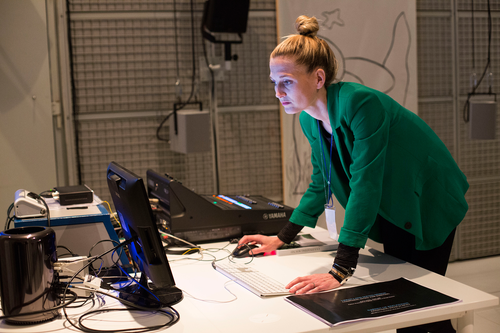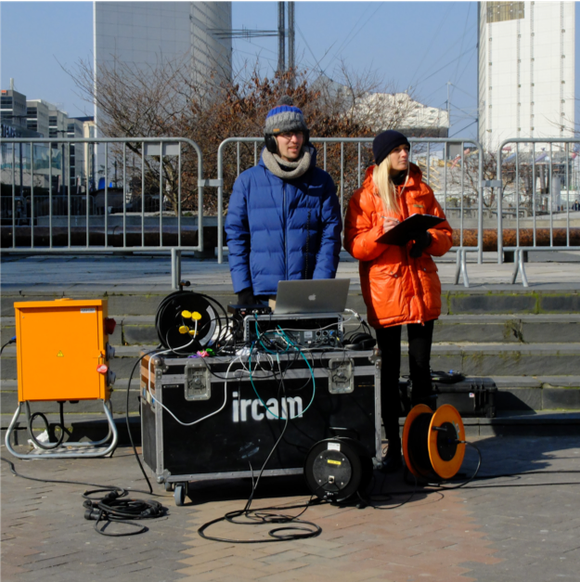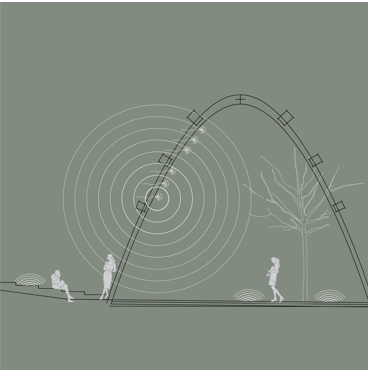Mastering hors du studio (5/5) : Nadine Schütz
Décryptons les nouvelles pratiques du mastering hors du studio avec Nadine Schutz, architecte du son et actuellement compositrice invitée en recherche à l'Ircam
 Pouvez-vous illustrer les circonstances qui vous poussent à utiliser d’autres supports ou quitter le studio pour mixer/faire du mastering dans des conditions spécifiques où votre musique/vos sons seront écoutés ?
Pouvez-vous illustrer les circonstances qui vous poussent à utiliser d’autres supports ou quitter le studio pour mixer/faire du mastering dans des conditions spécifiques où votre musique/vos sons seront écoutés ?
Je me présente comme une architecte du son, ou comme interprète environnementale. Mes créations se dimensionnent et se matérialisent toutes en fonction de lieux spécifiques sur lesquels j’interviens. J’en étudie les qualités acoustiques et les constellations sonores, que j’intègre, transforme, recompose. L’œuvre qui en résulte peut prendre des formes très différentes : installations, scénographies, atmosphères et spatialités acoustiques, instruments environnementaux ou objets sonores sculpturaux.
J’interroge le rôle du son dans la relation entre des personnes et leur environnement. Je m’intéresse beaucoup aux mouvements et changements, aux temporalités, à la vie et aux mémoires, aux aspects ambiants dynamiques, axes que je considère comme porteurs de relation inhérente et intime entre paysage, espace et son. En ce sens, ce que je fais pourrait être considéré comme un art environnemental, et, par conséquent, mes créations sonores ne trouvent leur accomplissement que dans leur environnement de destination.
 Les échelles sur lesquelles j’opère sont très différentes, de la scénographie intérieure temporaire aux interventions pérennes « en plein air », de l’espace public aux aménagements urbains complexes, en passant par des installations d’exposition indépendante ou des jardins sonore. Les projets urbains guident mon approche de la composition, car je suis architecte et paysagiste de formation. Concevoir, composer dans un environnement urbain ou paysager implique quasiment de travailler avec un site donné, sa structure physique, ses conditions sociales, ses usages et usagers. C’est plus récemment, et notamment à l’occasion de ma résidence à l’Ircam, que j’ai redécouvert le plaisir de composer dans un espace virtuel ou abstrait.
Les échelles sur lesquelles j’opère sont très différentes, de la scénographie intérieure temporaire aux interventions pérennes « en plein air », de l’espace public aux aménagements urbains complexes, en passant par des installations d’exposition indépendante ou des jardins sonore. Les projets urbains guident mon approche de la composition, car je suis architecte et paysagiste de formation. Concevoir, composer dans un environnement urbain ou paysager implique quasiment de travailler avec un site donné, sa structure physique, ses conditions sociales, ses usages et usagers. C’est plus récemment, et notamment à l’occasion de ma résidence à l’Ircam, que j’ai redécouvert le plaisir de composer dans un espace virtuel ou abstrait.
Photo 1 : Nadine Schutz en résidence en recherche artistique à l'Ircam, studio 1 © Ircam, photo : Sébastien Calvet
Photo 2 : Jardin des réflexions (La Défense) : installation-mobilier sonore pour la place de la Défense. Photo : mesures acoustiques du lieu avec l’équipe EAC de l’Ircam © Nadine Schütz, photo : Clément Willemin
Pendant une séance de mixage/mastering spécifique, quel(s) type(s) de transformation audio appliquez-vous à votre musique/vos sons ? Pensez-vous qu'une forme d’écoute dédiée soit nécessaire pour cette pratique ? Ce type d’opération(s) a-t-il modifié votre façon de travailler en général ?
Il me paraît important de préciser que, souvent, le dispositif (la conception de l’instrument) fait autant partie de mes œuvres que le contenu sonore (la composition). Dans ce sens, les dispositifs ne sont pas un appareillage de diffusion neutre. Ils sont « taillés » afin de contribuer de leur côté à la révélation sonore du lieu, en s’intégrant tantôt à des mâts d’éclairage (les Niches acoustiques pour le parvis du Tribunal de Grande Instance), à du mobilier urbain (le Jardin des réflexions pour La Défense) ou sur la charpente d’un pont (Les Instruments élémentaires pour le franchissement urbain Pleyel à Saint-Denis). Leur disposition peut également faire partie du processus de mixage/mastering in situ. La liberté que j’ai à ce niveau dépend du degré de leur « incorporation » dans des éléments architecturaux, des interfaces avec d’autres installations (i.e. la lumière). Ce travail sur le dispositif est aussi un équilibrage du rendu en fréquences par rapport aux résonances de l’espace de l’installation. Pour distinguer ces fréquences résonantes, j'utilise parfois la voix. Dans le cas de l'installation – scénographie sonore Chorus: Water and Voices réalisée pour l’exposition « One Planet One Future » dans la Westbeth Gallery à New York, cette procédure « low-tech » a fini par devenir une partie de l'œuvre même : en chantant les harmoniques sur la fréquence amplifiée et donc prédominante d'un bruit technique dérangeant, présent dans le lieu, j'ai réussi à masquer ce dernier – en l’intégrant dans un chorus humain.


Niches acoustiques : dispositif sonore pour le parvis du tribunal de grande instance de Paris à la Porte de Clichy, collaboration avec Moreau Kusunoki architectes.
Photos : visite du chantier en cours avec l’architecte Hiroko Kusunoki [à gauche]. Plan des niches sur le parvis du TGI, champs sonores [à droite] © Nadine Schütz, photo : Giovanna Carrer
Sur le plan de la composition, je travaille beaucoup sur la stratification de l’espace auditif, les comportements spatiaux des objets sonores et leur interaction avec la physique de l’espace. Le rendu sonore et musical de ces compositions ne peut être finalisé qu’in situ. Là, ces figures sonores vont se trouver confrontées à des dispositions spatiales souvent changeantes, aux sonorités déjà existantes sur site, et aussi à toutes les autres impressions, multisensorielles, du lieu. Dans la plupart des cas, je me retrouve à retirer, dénouer, dé-densifier, ralentir, c’est-à-dire à « filtrer » sur différents plans et dimensions ce que j’avais préparé en studio. Réduire la complexité, rendre plus transparent, donner du temps à écouter.
Pour faire cela, une écoute critique qui arrive à se détacher de l’imaginaire sonore développé lors de la préparation en studio, et écouter à nouveau, est indispensable. C’est aussi une écoute humble, qui prend en compte que, surtout pour les œuvres sonores dans l’espace urbain, le public qui l’entendra ne vient pas spécifiquement sur place pour écouter. Bien sûr, il y a toujours un espoir d’éveiller, de stimuler une curiosité auditive, d’embellir l’expérience sonore du lieu – tout ça en avouant que cet espoir se positionne pour des auditeurs sur leur chemin quotidien au travail, entre maison et station de métro. Je considère cette condition d’écoute comme une contrainte importante dans mes interventions. J’ai envie de proposer aux usagers des espaces urbains dans lesquels j’interviens une écoute libre, leur donner le choix. Cette idée de liberté fait partie d’un apprentissage continu sur ce type d’opération, et consiste à s’exposer à une dynamique de négociation entre contrôle et non-contrôle dans la création, qui peut être déstabilisante, mais surtout inspirante.
Comment vous adaptez-vous aux variations éventuelles des caractéristiques d’écoute du lieu ou support spécifique de diffusion, comme, par exemple, différents types d’environnement autour de l’auditeur (présence d’autres personnes, bruits de fond variables, musiques additionnelles…) ?
 L’adaptabilité et l’évolutivité d’une composition aux fluctuations des conditions environnementales et d’usage, c’est précisément ma réflexion sur ces créations. Elles cherchent en vérité à rendre une composition naturellement « vivante », comme un paysage.
L’adaptabilité et l’évolutivité d’une composition aux fluctuations des conditions environnementales et d’usage, c’est précisément ma réflexion sur ces créations. Elles cherchent en vérité à rendre une composition naturellement « vivante », comme un paysage.
Actuellement, je travaille sur plusieurs œuvres dans lesquels j’expérimente sur des systèmes d’interactions et d’harmonisation environnementale : comment le paysage peut devenir une sorte de chef d’orchestre pour ce qui s’entendra aux différentes heures de la journée, aux différentes saisons, par rapport aux données sonores actuelles du site et en fonction du temps qu’il fait. Les réponses sont multiples, mais passent toutes par une exigence et un temps long de mixage/mastering in situ itératif.
Pour des œuvres électroacoustiques pérennes, il s’agit aussi de réfléchir à une méthode de renouvellement périodique des contenus sonores, qui peut aller de pair avec le développement d’outils de gestion et de pilotage à distance. Dans la longue durée, il s’agit toujours de trouver un bon mix entre travail in situ et à distance, pour gérer et programmer. Néanmoins, le travail méthodologique sur ce mix s’impose également à l’ensemble de la démarche de composition pour des lieux spécifiques.
Je développe avec l’Ircam une méthodologie de composition en différentes étapes : la restitution de la qualité acoustique d’un site et de ses ambiances sonores dans le studio comme base/contexte de création, puis la transition/transposition du travail de composition et de simulation/préfiguration au studio et enfin son lieu de destination, son installation in situ. Si j'ai le choix, je préfère travailler en studio, en exploitant la technique Ambisonics (HOA), pour cela – en utilisant des ambiances enregistrées in situ et des mesures des réponses impulsionnelles pour y mixer les sons de ma création – car le port d'un casque sur les oreilles incite toujours une certaine intériorisation/individualisation de l'écoute, alors que ce que je cherche c'est une écoute partagée. Il me paraît important d’atteindre une certaine continuité et réciprocité entre ces étapes. Même si le site n’est parfois pas encore là…
Visuel : Instruments élémentaires : installations et sculptures sonores pour le franchissement urbain Pleyel à Saint Denis, collaboration avec Marc Mimram. SDessin de l'instrument « vent » avec son mémoire éolien © Nadine Schütz